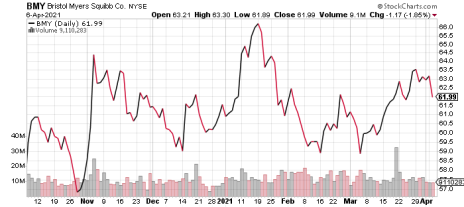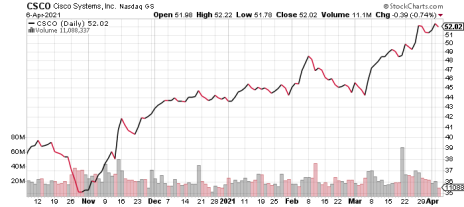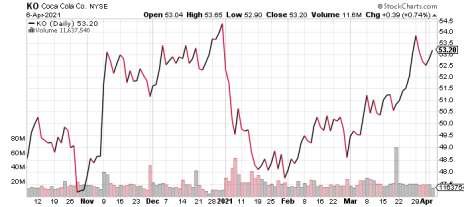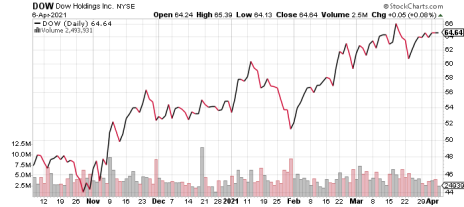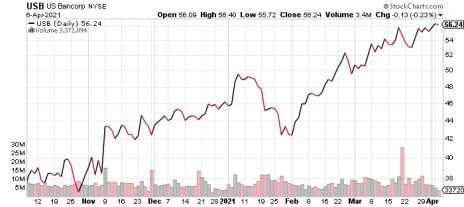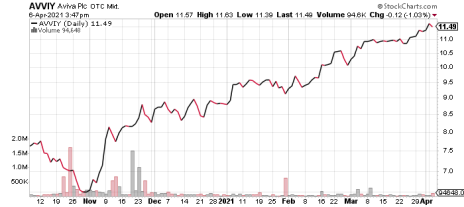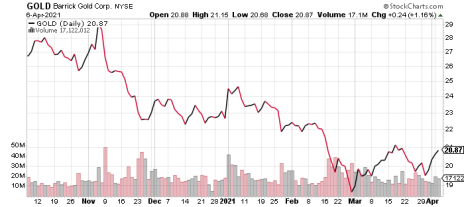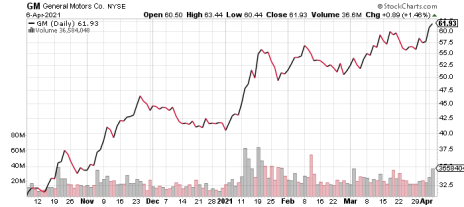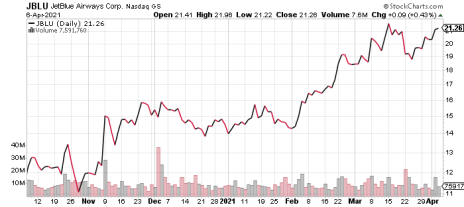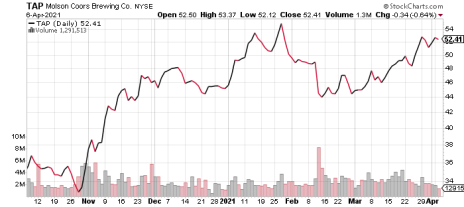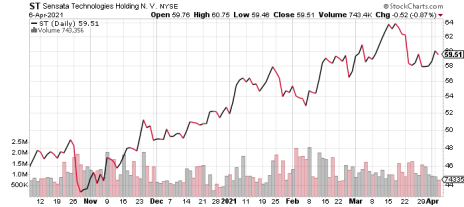Thank you for subscribing to the Cabot Undervalued Stocks Advisor. We hope you enjoy reading the April 2021 issue.
As value investors, we look for companies that are selling at a discount to their underlying value. But how do we measure that value? In this issue, we briefly describe and discuss the EV/EBITDA metric, which is our preferred valuation tool.
While our stocks generally did well this past week, there wasn’t much news. With earnings season starting next week, most companies are remaining fairly quiet.
One change we made was to reduce our rating on Tyson (TSN) from a Buy to a Hold. The shares have about 8% upside to our recently raised price target. From here, we’d like to learn more about its earnings power, which hopefully will be provided in its fiscal second quarter report, before deciding to either raise or sell.
Please feel free to send me your questions and comments. This newsletter is written for you and the best way to get more out of the letter is to let me know what you are looking for.
I’m best reachable at Bruce@CabotWealth.com. I’ll do my best to respond as quickly as possible.
Thanks!
Cabot Undervalued Stocks Advisor 421
[premium_html_toc post_id="228383"]
What is EBITDA and Why Do We Use It?
As one might expect in a value-oriented investment advisory, we focus a lot on a company’s valuation. We want to understand what the company is worth, both today and in the foreseeable future, and then buy its shares at some discount to that value.
Determining a company’s underlying value is difficult, and more of an art than a science. There are many valuation approaches, including using a price/earnings multiple, discounted cash flow, EV/EBITDA multiple and net asset value. No metric is perfect – what probably matters most is using a metric repeatedly to develop a deep and broad perspective on its advantages and limitations, and having an open and thoughtful mind when applying it.
Our preferred metric is the EV/EBITDA multiple. We’ve used it for many years, have delved deep into the theory behind it1, and, most importantly, have found it to be effective in selecting successful investments.
EBITDA is earnings before interest, taxes, depreciation and amortization. By stripping away the interest and taxes, as well as non-cash charges for depreciation and amortization, EBITDA measures the operating cash profits of the company. This is the heart of what makes a company valuable – its ability to generate cash operating profits.
EV stands for “enterprise value.” It includes the value of the equity (its market capitalization) plus any debt, less any cash since cash can be used to offset debt. One way to think about enterprise value is that it is the total price that a buyer would pay to acquire the entire business, or enterprise. Another way: the operations of a business have a stand-alone value, and that value is carved up among debt holders and equity holders.
By comparing the value of the business to the size of the cash operating profits, we can get a sense of its cheapness or expensiveness. It is similar to the price/earnings multiple, but with different components.
One major benefit of the EV/EBITDA approach is that it can be used to compare similar companies with different capital structures. Another important benefit is that it removes a distortion of net income created by low interest rates. With low interest rates, a company could borrow vast amounts of debt yet only see its net income modestly penalized. But, clearly, the debt has a claim on the business so it can’t be ignored, and this burden is captured by the EV/EBITDA ratio much more effectively than by the price/earnings ratio.
Also, by focusing on cash flow, it removes some opportunities to be misled by any manipulation of earnings per share by company management.
The EV/EBITDA approach has flaws, of course. It ignores the real cash costs of interest expenses, taxes and capital spending requirements. To effectively capture these, an investor needs to model all of the cash flows of a business, which include working capital changes, restructuring payouts and divestitures, as common examples. We do this for all of our recommended stocks. We also make other adjustments, such as considering the accumulation of free cash flow over a two-to-three-year horizon. This build-up of cash is one of the most neglected sources of value in the stock market.
Hopefully this is helpful to you. Please reach out to ask questions about our use of this metric!
[1] The concept behind this multiple is that the operating part of the company should be separated from the financing part. This was formalized in a theory by two University of Chicago professors, Merton Miller and Franco Modigliani, who first proposed in 1958 that the value of a company (its operations) is independent from its capital structure. The company could be capitalized entirely with equity, or entirely with debt, or some other mix, yet its value would not be affected. For their Miller-Modigliani Theorem, they won a Nobel Prize in 1985. While their theory made some generous assumptions, including ignoring the real-world effect of taxes, bankruptcy risk, agency costs and asymmetric information, it has been fully accepted and is widely used on Wall Street and in private equity.
Earnings season will start next week. If you have the time and inclination, listen to the management call that accompanies each report. You can find access information under the company’s “Investor Relations” tab on their website. The calls are webcast and open to the public. Most are available for a few weeks or longer for those not able to listen to the live webcast.
The management and brokerage analysts often use a lot of jargon, which can make the dialog difficult to follow at times. Fortunately, the companies usually provide a slide deck that highlights the results in a fairly straightforward manner (although they usually de-emphasize the “low-lights”). Often, clicking through a slide deck can quickly help you become more familiar with your company and its operations, which not only can help you keep your resolve when things slip but also provide a fascinating window into what the company is doing and its priorities.
Share prices in the table reflect Tuesday (April 6) closing prices. Please note that prices in the discussion below are based on mid-day April 6 prices.
Note to new subscribers: You can find additional color on recent earnings and other news on recommended companies in prior editions of the Cabot Undervalued Stocks Advisor on the Cabot website.
Send questions and comments to Bruce@CabotWealth.com.
Upcoming Earnings Releases
April 14: U.S. Bancorp (USB)
April 19: Coca-Cola (KO)
April 20: JetBlue (JBLU)
April 22: Dow (DOW)
Today’s Portfolio Changes
Tyson (TSN) – Moving from Buy to Hold.
Portfolio changes during the past month
Barrick Gold (GOLD) – new Buy
Tyson (TSN) – Raising price target from 75 to 82.
JetBlue (JBLU) – Raising price target from 19 to 22.
Growth & Income Portfolio
Growth & Income Portfolio stocks are generally higher-quality, larger-cap companies that have fallen out of favor. They usually have some combination of attractive earnings growth and an above-average dividend yield. Risk levels tend to be relatively moderate, with reasonable debt levels and modest share valuations.
| Stock (Symbol) | Date Added | Price Added | 4/6/21 | Capital Gain/Loss | Current Dividend Yield | Price Target | Rating |
| Bristol-Myers Squibb (BMY) | 04-01-20 | 55 | 62 | 13.5% | 3.2% | 78 | Strong Buy |
| Cisco Systems (CSCO) | 11-18-20 | 42 | 52 | 23.3% | 2.8% | 55 | Buy |
| Coca-Cola (KO) | 11-11-20 | 54 | 53 | -1.4% | 3.1% | 64 | Buy |
| Dow Inc (DOW) | 06-05-18 | 68 | 65 | -5.5% | 4.3% | 70 | Hold |
| Merck (MRK) | 12-9-20 | 83 | 76 | -8.7% | 3.4% | 105 | Buy |
| Tyson Foods (TSN) | 12-10-19 | 89 | 76 | -14.8% | 2.3% | 82 | Hold |
| US Bancorp (USB | 12-29-20 | 46 | 56 | 21.4% | 3.0% | 58 | Buy |
Bristol Myers Squibb Company (BMY) is a New York-based $142 billion (market cap) global biopharmaceutical company with over $45 billion in revenues. In recent years it has divested several major businesses to focus on high-value pharmaceuticals. BMY shares sell at a low absolute valuation and a sharp discount relative to peers due to worries over upcoming patent expirations for Revlimid (starting in 2022) and Opdivo and Eliquis (starting in 2026). With this overhang, as well has having many other faster-growing biotech companies to choose from, investors currently have little interest in Bristol Myers shares.
The shares are attractive for two reasons. First, the low valuation provides a very appealing risk/reward trade-off. Low expectations are already built into the share price, likely minimizing the downside risk should the anticipated weak fundamentals actually arrive. And, if the fundamental reality is stronger than feared, the shares provide considerable upside potential.
Second, Bristol is taking smart and aggressive steps to minimize its fundamental risk. Left untreated, the patent expirations could potentially leave Bristol with sharply lower revenues and profits, so its revenue-and-profit-replacement strategy is the correct one, other than a pure wind-down (another fascinating and viable strategy but not one contemplated here).
Bristol is taking a multi-step approach with its strategy. First, it is working to lengthen its patent protection window for its core products. Deals with generics producers to slow new competition for Revlimid, as well as its partnership agreement with Pfizer last year to expand its Eliquis franchise, help taper the likely size and pace of revenue declines in these franchises. And, these “key three” products have strong underlying demand (their current revenue growth remains robust), indicating that pricing, not volumes, is the primary risk. This demand provides Bristol with considerable flexibility to continue to defend its revenues with new treatment combinations and variations.
Additionally, the company’s acquisitions of Celgene ($80 billion in late 2019) and MyoKardia ($13 billion in late 2020) provide attractive new products with considerable growth potential that complement Bristol’s research expertise. Bristol is using its currently-hefty free cash flow to pay down much of the debt incurred in these deals.
Lastly, Bristol has a robust pipeline of internally developed treatments that offer potentially sizeable new revenues.
All-in, it is likely that the worst-case scenario for Bristol Myers is flat revenues over the next 3-5 years, with a healthy likelihood of at least some incremental growth. Any indication that revenues can sustain the patent expirations should boost BMY’s share price considerably.
Also mitigating the risk, the company is aggressively cutting its costs, including the announced $2.5 billion efficiency program.
Earnings for 2021 are estimated to increase 16%, although tapering to 6-8% in future years. The company is positioned, backed by management guidance, to generate between $45 billion and $50 billion in cash flow over the three years of 2021-2023. This sum is equal to 35% of the company’s $136 billion market value. The balance sheet carries $16 billion in cash and its debt is only 2x EBITDA.
Agios Pharmaceutical will repurchase $345 million of its shares that Bristol currently holds, as part of a new share repurchase program. This agreement will provide Bristol with incremental cash.
A recent article in the New York Times said that an accidental disclosure by the IRS revealed that Bristol is in a tax dispute for as much as $1.4 billion in back-taxes related to an offshore subsidiary. No further disclosures have apparently been made. We would like to see an update in the upcoming earnings report.
BMY shares ticked down about 1% in the past week and have about 24% upside to our 78 price target. The stock hasn’t moved much in over a year, yet the company continues to generate about $7/share in free cash flow, about $2 of which is paid out in dividends. We remain patient with BMY shares.
The stock trades at a low 8.4x estimated 2021 earnings of $7.49 (unchanged from last week). On 2022 estimated earnings of $8.07 (unchanged), the shares trade at 7.8x. Either we are completely wrong about the company’s fundamental strength, or the market must eventually recognize Bristol’s earnings stability and power. We believe the earning power, low valuation and 3.1% dividend yield that is well-covered by enormous free cash flow makes a compelling story. STRONG BUY.
Cisco Systems (CSCO) generates about 72% of its $48 billion in revenues from equipment sales, including gear that connects and manages data and communications networks. Other revenues are generated from application software, security software and related services, providing customers a valuable one-stop-shop. Cisco is shifting toward a software and subscription model and ramping new products, helped by its strong reputation and its entrenched position within its customers’ infrastructure.
The emergence of cloud computing has reduced the need for Cisco’s gear, leading to a stagnant/depressed share price. Cisco’s prospects are starting to improve under CEO Chuck Robbins (since 2015). The company is highly profitable, generates vast cash flow (which it returns to shareholders through dividends and buybacks) and has a very strong balance sheet.
While fiscal second quarter earnings were bland on the surface, the company looks positioned to start showing revenue growth. With low investor expectations, any revenue growth is helpful. Cisco’s balance sheet remains solid.
There was no significant company news in the past week.
CSCO shares rose 1% in the past week and have about 5% upside to our 55 price target.
The shares trade at 16.2x estimated FY2021 earnings of $3.22 (down a cent in the past week). On FY2022 earnings (which ends in July 2022) of $3.43 (unchanged), the shares trade for 15.2x. On an EV/EBITDA basis on FY2021 estimates, the shares trade at a discounted 11.3x multiple. CSCO shares offer a 2.8% dividend yield. We continue to like Cisco. BUY.
Coca-Cola (KO) is best-known for its iconic soft drinks but nearly 40% of its revenues come from non-soda brands across the non-alcoholic spectrum, including PowerAde, Fuze Tea, Glaceau, Dasani, Minute Maid and Schweppes. Its vast global distribution system offers it the capability of reaching essentially every human on the planet.
While near-term outlook is clouded by pandemic-related stay-at-home restrictions, secular trends away from sugary sodas, high exposure to foreign currencies and always-aggressive competition, Coca-Cola’s longer-term picture looks bright. Relatively new CEO James Quincey (2017), a highly regarded company veteran with a track record of producing profit growth and making successful acquisitions, is reinvigorating the company by narrowing its oversized brand portfolio, boosting its innovation and improving its efficiency. The company is also working to improve its image (and reality) of selling sugar-intensive beverages that are packaged in environmentally-insensitive plastic. Coca-Cola is supported by a sturdy balance sheet. Its growth investing, debt service and $0.42/share quarterly dividend are well-covered by free cash flow.
Coca-Cola’s subdued near-term revenue and profit outlook is somewhat driven by pandemic-related lockdowns, particularly outside of the United States. Consensus estimates point to 10% revenue and earnings per share growth in 2021. Another overhang is the tax dispute that could cost as much as $12 billion – we don’t see an immediate resolution but consider $12 billion to be a worst-case scenario. Coke will likely continue to generate robust free cash flow in 2021.
The risk of fresh lockdowns and delayed re-openings in Germany and other European countries will likely push out the full recovery of Coca-Cola.
There was no significant company news in the past week.
KO shares were flat in the past week and have about 20% upside to our 64 price target. While the valuation is not statistically cheap, at 24.8x estimated 2021 earnings of $2.15 (unchanged in the past week) and 22.9x estimated 2022 earnings of $2.33 (unchanged), the shares are undervalued while also offering an attractive 3.1% dividend yield. BUY.
Dow Inc. (DOW) merged with DuPont in 2017 to temporarily create DowDuPont, then split into three companies in 2019 based roughly along product lines. The new Dow is the world’s largest producer of ethylene/polyethylene, the most widely used plastics. Dow is primarily a cash-flow story driven by three forces: 1) petrochemical prices, which are often correlated with oil prices and global growth, along with competitors’ production volumes; 2) volume sold, largely driven by global economic conditions, and 3) ongoing efficiency improvements (a never-ending quest of all commodity companies to maintain their margins).
Dow continues to participate in the economic recovery. For 2021, analysts estimate revenue growth to be 14%, aided by higher prices and volumes. The strong U.S. dollar may be a modest headwind as it makes revenues produced in other currencies less valuable when translated into dollars. Generous free cash flow will partly be used to trim Dow’s debt.
There was no significant company news in the past week.
Dow shares rose 1% this past week and have about 8% upside to our recently raised 70 price target. The shares trade at 17.4x estimated 2022 earnings of $3.75, although these earnings are more than a year away. This estimate was unchanged in the past week. The 2021 earnings estimate rose 1% in the past week, reflecting incremental optimism over the improving economy.
The high 4.3% dividend yield is particularly appealing for income-oriented investors. Dow currently is more than covering its dividend and management makes a convincing case that it will be sustained. HOLD.
Merck (MRK) – Pharmaceutical maker Merck focuses on oncology, vaccines, antibiotics and animal health. Keytruda, a blockbuster oncology treatment representing about 30% of total revenues, holds an impressive franchise that is growing at a 20+% annual rate. To tighten its focus, Merck will spin off its Women’s Health, biosimilars and various legacy branded operations, to be named Organon, by mid-year 2021. These businesses currently generate roughly 15% of Merck’s total revenues yet comprise half of its product roster. We estimate that Organon is worth about $3.75 per MRK share. The spin-off will yield an $8-$9 billion cash inflow to Merck. Longer term, we see the company spinning out or selling its animal health business. Merck has a solid balance sheet and is highly profitable. With the new CEO, we see the company becoming more acquisitive to find additional growth products, which adds both risk and return potential to the Merck story.
Primary risks include its dependence on the Keytruda franchise which will face generic competition in late 2028, possible generic competition for its Januvia diabetes treatment starting in 2022, and the possibility of government price controls.
Merck’s earnings for 2021 and 2022 are estimated to increase by about 10%.
There was no significant company news in the past week.
For much of this year, we anticipate that the stock will be moderately volatile or remain weak until the effects of the strategic changes are more clearly seen. Longer term, the low valuation, strong balance sheet and sturdy cash flows provide real value. The 3.4% dividend yield pays investors to wait.
Merck shares slipped 1% this past week and have about 37% upside to our 105 price target. Valuation is an attractive 11.7x this year’s estimated earnings of $6.51 (unchanged in the past week). Merck produces generous free cash flow to fund its current dividend as well as likely future dividend increases, although its shift to a more acquisition-driven strategy will slow the pace of increases. BUY.
Tyson Foods (TSN) is one of the world’s largest food companies, with nearly $43 billion in revenue. Beef products generate about 36% of total revenues, while chicken (31%), pork (10%), and prepared/other contribute the remaining revenues. It has the #1 domestic position in beef and chicken with roughly 21% market share in each. Its well-known brands include Tyson, Jimmy Dean, Hillshire Farms, Ball Park, Wright and Aidells. Tyson’s long-term growth strategy is to participate in the growing global demand for protein. The company has more work to do to convince investors that its future is brighter, particularly as it is more of a commodity company (and hence has lower margins) compared to its food processor peers. Dean Banks, the new CEO, who previously was an Alphabet/Google executive, is starting to make necessary changes.
Tyson’s fiscal 2021 earnings (ends in September) are estimated to increase about 1%, but accelerate to the 10% range in future years. Fiscal 2021 will be hindered by subdued volumes and pricing. The Prepared Foods segment will likely see higher profits, but this is a small segment for Tyson. Faster domestic and neighboring country (Mexico in particular) re-openings should help lift chicken and other meat prices and volumes.
There was no significant company news in the past week.
The stock was flat in the past week and has 8% upside to our recently raised 82 price target. While the near-term outlook is mixed, the new management is likely being conservative with its forward guidance. However, we are reducing our rating to a HOLD given the relatively modest upside to our target. If the earnings report indicates that the company’s earning power is noticeably higher, we will re-evaluate our price target.
Valuation is reasonable at 13.3x estimated 2021 earnings of $5.71 (up 2 cents in the past week). Currently the stock offers a 2.3% dividend yield. HOLD.
U.S. Bancorp (USB), with a $70 billion market value, is the one of the largest banks in the country. It focuses is on consumer and commercial banking through its 2,730 branches in the Midwest, southwest and western United States. It also offers a range of wealth management and payments services. Unlike majors JP Morgan, Bank of America and Goldman Sachs, U.S. Bancorp has essentially no investment banking or trading operations. USB shares remain out of favor due to worries about a potential surge in pandemic-driven credit losses and weaker earnings due to the low interest rate environment.
U.S. Bancorp’s 2021 earnings are expected to increase about 25% compared to the pandemic-weakened 2020 results, with future earnings growth of perhaps 9-11%.
USB shares (like most bank shares) continue to trade with the 10-year Treasury yield. Rising interest rates combined with a stronger economy make the bank more valuable. The yield currently sits at 1.67%. For reference, the yield was 1.88% at year-end 2019, just before the pandemic. Short-term interest rates have remained essentially unchanged.
There was no significant company news in the past week.
USB shares rose 1% in the past week and have about 3% upside to our 58 price target. While the upside to our price target is now modest, we are maintaining our Buy rating for now. We’d like to see how first quarter earnings look, which might change our view on U.S. Bancorp’s value.
Valuation is 13.2x estimated 2022 earnings of $4.25 (up two cents in the past week). On a price/tangible book value basis, USB shares trade at a 2.3x multiple of the $24.85 tangible book value. This ratio ignores the value of the bank’s payments, investment management and other service businesses that have low tangible book values but produce steady and strong earnings. For perspective, JPMorgan, considered the highest quality and best-managed bank, with sizeable capital markets operations, trades at 2.4x tangible book value. Currently, USB stock offers a 3.0% dividend yield. BUY.
Buy Low Opportunities Portfolio
Buy Low Opportunities Portfolio stocks include a wide range of value opportunities, often with considerable upside. This group may include stocks across the quality and market cap spectrum, including those with relatively high levels of debt and a less-clear earnings outlook. The stocks may not pay a dividend. In all cases, the shares will trade at meaningful discounts to our estimate of fair value.
| Stock (Symbol) | Date Added | Price Added | 4/6/21 | Capital Gain/Loss | Current Dividend Yield | Price Target | Rating |
| Aviva (AVVIY) | 03-02-21 | 10 | 12 | 9.9% | 5.1% | 14 | Buy |
| Barrick Gold (GOLD) | 03-16-21 | 21 | 21 | 0.4% | 1.7% | 27 | Buy |
| General Motors (GM) | 12-31-19 | 37 | 62 | 69.6% | — | 62 | Hold |
| JetBlue (JBLU) | 11-25-20 | 16 | 21 | 34.5% | — | 22 | Hold |
| Molson Coors (TAP) | 08-04-20 | 37 | 52 | 42.6% | — | 59 | Buy |
| Sensata Technologies (ST) | 02-16-21 | 59 | 59 | 0.6% | — | 75 | Buy |
Aviva, plc (AVVIY) – Based in London, England, Aviva is a major European insurance company specializing in life insurance, savings and investment management products. Its market cap is about $21 billion. Long a mediocre company, the frustrated board last July installed Amanda Blanc as the new CEO, with the task of fixing the business. She is aggressively re-focusing the company on its core geographic markets (UK, Ireland, Canada), while putting its remaining geographies on the selling block. Recently, Aviva announced the sale of its operations in Turkey, Italy and France. The turnaround also includes improving Aviva’s product competitiveness, rebuilding its financial strength and trimming its bloated costs. The new leadership reduced the company’s dividend, but to a more predictable and sustainable level, along with what is likely to be a modest but upward trajectory.
Aviva reported healthy full-year operating profit of £3.2 billion, roughly flat with a year ago but higher than consensus estimates. Management is targeting £1.7 billion in debt reduction in the first half of 2021 and guided to greater than £5 billion in cumulative cash remittances between 2021-2023. As an insurance company, Aviva must retain specified amounts of cash at its subsidiaries – but excess cash above this minimum, after a cushion, can be remitted to the parent company. Cash remittances, particularly when backed by a publicly stated target, indicate surplus financial strength that can be returned to investors.
Aviva’s capital strength is improving, indicated by its Solvency II shareholder cover ratio at 202%. This ratio is based on a complex European regulatory measure of how much capital an insurance company holds compared to a minimum required amount of 100%. The company has stated that it will pay out any capital above a 180% ratio, which could mean a major share repurchase or special dividend to shareholders equal to as much as 15% of the company’s market value.
Stronger capital, higher cash remittances, lower debt and better profits suggest that the company may be able to raise its dividend more aggressively than the stated modest pace.
There was no significant company news in the past week.
Aviva shares rose 2% this past week and have about 21% upside to our 14 price target. The stock trades at 7.7x estimated 2021 earnings per ADS of $1.50 (unchanged this past week) and about 94% of tangible book value. AVVIY shares offer an attractive and likely solid and recurring 5.0% dividend yield. BUY.
Barrick Gold (GOLD) – Barrick is one of the world’s largest and highest-quality producers of gold. Based in Toronto, Canada, the company has mining operations around the world, with about 50% of production in North America, 32% in Africa and the Middle East and 18% in Latin America and Asia Pacific. The company also has smaller copper mining operations. Barrick’s market capitalization is about $37 billion.
This stock is not only out of favor (a classic contrarian trait), but is also not infrequently looked upon with doubt, disdain and discredit. The entire gold mining industry isn’t immune to such views, either. But the gold mining industry, and certainly Barrick, has lost the loose-spending and often murky culture of decades ago. After a long struggle with disappointing profitability and low returns on capital, today’s gold mining industry is one of restraint, transparency and financial discipline.
Barrick’s chairman is a former Goldman Sachs president, hardly someone who would want to waste shareholder money. Since taking the chairman’s seat in 2014, his signature achievement over the subsequent 4½ years was slashing costs and paying down Barrick’s entire $13 billion of net debt.
Barrick’s shares surged in 2019 and early 2020 by the combination of rising gold prices and the arrival of a highly capable new CEO, Mark Bristow, in January 2019. Bristow joined Barrick when it acquired Randgold Resources, a major South African mining company that he founded. He is highly regarded for his ability to manage portfolios of gold mines, reduce costs and navigate the complicated process of operating mines in less-developed countries that yearn for the revenues that gold mines (which obviously can’t be relocated) generate. Impressively, in his first year at Barrick, Bristow created a joint venture that combined Barrick’s and Newmont Mining’s Nevada gold mines into a single world-class operation, generating large cost and productivity improvements.
Since their mid-2020 peak at around $2,000/ounce, gold prices have slipped about 15% to $1,730/ounce. Barrick’s shares have slid over 30% – not completely surprising as mining company stocks magnify the moves in the underlying commodity. With the fall-off in the share price, Barrick shares now have considerable appeal.
Our thesis is based on two points. First, that Barrick will continue to generate strong free cash flow at current gold prices, continue to improve its operating performance and return much of that free cash flow to investors while making minor but sensible acquisitions. Demonstrating its commitment, the company will pay $0.42/share in special distributions this year, in addition to its regular $0.09/share quarterly dividend. Barrick’s balance remains solid, with its $5.2 billion in debt fully offset by its cash balance.
Second, that Barrick shares offer optionality – if the enormous fiscal stimulus, rising taxes and heavy central bank bond-buying produces stagflation and low interest rates, then the price of gold will move upward and lift Barrick’s shares with it. Given their attractive valuation, the shares don’t need this second (optionality) point to work – it offers extra upside.
Major risks include the possibility of a decline in gold prices, production problems at its mines, making a major acquisition and/or an expropriation of one or more of its mines.
The combined dividends this year will produce a 3.7% yield. Although the company may not pay a special dividend next year, it could raise its recurring dividend to provide an above-market yield. We think Barrick has a much better future than the market is assuming.
The prime minister of Papua New Guinea announced that it is close to a new agreement with Barrick to re-open the Porgera mine, which previously produced about 5% of Barrick’s global output. Barrick’s contract with the country to operate the mine expired in August 2019, which later led to a dispute. The mine was put on “care and maintenance.” New terms haven’t been announced but are likely to allocate a higher proportion of ownership to the government. One of CEO Mark Bristow’s skills is successfully negotiating these complicated agreements – we’ll see more on this agreement once it is finalized.
Barron’s magazine wrote favorably about Barrick in its recent edition, speaking highly of its leadership, high-quality mines, attractive valuation and strong free cash flow that may start to flow into shareholders’ pockets. The article described how the CEO, Mark Bristow, reiterated his discipline in making acquisitions.
Barrick shares rose 8% this past week and have about 29% upside to our 27 price target. The stock trades at a sizeable discount to our value estimate of 27, based on 7.5x estimated 2021 EBITDA and at a modest premium to its $25/share net asset value.
On its recurring $.09/quarter dividend, GOLD shares offer a reasonable 1.7% dividend yield. BUY.
General Motors (GM) under CEO Mary Barra (since 2014) has transformed from a lumbering giant to a well-run and (almost) respected auto maker. The company has smartly exited many chronically unprofitable geographies (notably Europe) and trimmed its passenger car roster while boosting its North American market share with increasingly competitive vehicles, particularly light trucks. We consider its electric and autonomous vehicle efforts to be near industry-leading. We would say it is perhaps 75% of the way through its gas-powered vehicle turnaround and is well-positioned but in the very early stages of its EV development. GM’s balance sheet is sturdy, with Automotive segment cash exceeding Automotive debt. Its credit operations are well-capitalized but may yet be tested as the pandemic unfolds.
General Motors is estimated to produce about 14% higher revenues in 2021, but earnings are expected to increase only about 6% (to about $5.21) due to near-term headwinds from tight semiconductor chip supplies. GM Financial will likely continue to be a sizeable profit generator.
GM announced that it plans to produce an all-electric Silverado pickup truck when construction is completed at its new flagship EV assembly plant in Detroit.
GM shares rose 5% in the past week and have 1% upside to our 62 price target.
On a P/E basis, the shares trade at 9.8x estimated calendar 2022 earnings of $6.29 (up two cents this past week). The P/E multiple is helpful, but not a precise measure of GM’s value, as it has numerous valuable assets that generate no earnings (like its Cruise unit, which is developing self-driving cars and produces a loss), its nascent battery operations, its Lyft stake and other businesses with a complex reporting structure, nor does it factor in GM’s high but unearning cash balance which offsets its interest-bearing debt. However, it is useful as a rule-of-thumb metric, and provides some indication of the direction of earnings estimates, and so we will continue its use here.
Our 62 price target is based on a more detailed analysis of GM’s various components and their underlying valuation. HOLD.
JetBlue Airlines (JBLU) is a low-cost airlines company. Started in 1999, the company serves nearly 100 destinations in the United States, the Caribbean and Latin America. The company’s revenues of $8.1 billion in 2019 compared to about $45 billion for legacy carriers like United, American and Delta, and were about a third of Southwest Airlines ($22 billion). Its low fares and high customer service ratings have built strong brand loyalty, while low costs have helped JetBlue produce high margins. Its TrueBlue mileage awards program, which sells miles to credit card issuers, is a recurring source of profits.
We believe consumers (and eventually business travelers) are likely to return to flying. JetBlue has aggressively cut its cash outflow to endure through the downturn. Although its $4.4 billion debt is elevated, its $2.0 billion cash balance gives the airline plenty of time to recover. JBLU shares carry more risk than the typical CUSA stock.
JetBlue’s revenues currently are projected to take until 2023 to fully recover to their 2019 level. EBITDA (earnings before interest, taxes, depreciation and amortization, which is a measure of cash operating earnings), is estimated to fully recover by 2022. JetBlue has improved its cost structure during the pandemic, helping rebuild profits sooner than revenues.
TSA traffic remains strong, at about 66% of the approximately comparable week in 2019. Our informal research into airfares points to elevated prices over the next month or two, suggesting that lower volumes doesn’t necessarily mean lower revenues and profits. Demand even with high prices appears robust this year.
There was no significant company news in the past week.
JBLU shares rose 6% this past week and have about 1% upside to our recently raised 22 price target. We are keeping JBLU shares on a short leash.
The stock trades at 10.3x estimated 2023 earnings of $2.12. This estimate rose about 4% in the past week. We are watching the 2021 estimated loss per share to quantify near-term conditions. This estimate deteriorated to $(2.50), by 1 cent, compared to a week ago. On an EV/EBITDA basis, the shares trade at 5.8x estimated 2023 EBITDA. HOLD.
Molson Coors Beverage Company (TAP) – The thesis for this company is straight-forward – a reasonably stable company whose shares sell at an overly discounted price. One of the world’s largest beverage companies, Molson Coors produces the highly recognized Coors, Molson, Miller and Blue Moon brands as well as numerous local, craft and specialty beers. About two-thirds of its $10 billion in net revenues are produced in the United States, where it holds a 24% share of the beer market.
Investors’ primary worry about Molson Coors is its lack of meaningful (or any) revenue growth as it produces relatively few of the fast-growing hard seltzers and other trendier beverages. Our view is that the company’s revenues are resilient, it produces generous cash flow and is reducing its debt, traits that are value-accretive and underpriced by the market. A new CEO is helping improve its operating efficiency and expand carefully into more growthier products.
Molson is estimated to produce about 5% revenue growth and a 3% decline in per share earnings in 2021. Profit growth is projected to increase to a 2-3% rate in future years. Weakness this year is closely related to the sluggish re-opening of the European economies, along with higher commodity and marketing costs. The company will likely re-instate its dividend later this year, which could provide a 2.7% yield.
The risk of fresh lockdowns and delayed re-openings in Germany and other European countries will likely push out the full recovery of MolsonCoors.
There was no significant company news in the past week.
TAP shares rose 1% in the past week and have about 12% upside to our 59 price target. Earnings estimates ticked down fractionally this past week, with no change to the 2021 estimate and a 2-cent decline in the 2022 estimate. TAP shares trade at 13.9x estimated 2021 earnings of $3.81.
On an EV/EBITDA basis, or enterprise value/cash operating profits, the shares trade for about 9.2x current year estimates, among the lowest valuations in the consumer staples group and well below other brewing companies.
For investors looking for a stable company trading at a low valuation, TAP shares continue to have contrarian appeal. Patience is the key with Molson Coors. We think the value is solid although it might take a year or two to be fully recognized by the market. BUY.
Sensata Technologies (ST) is a $3 billion (revenues) producer of an exceptionally broad range (47,000 unique products) of sensors used by automotive, industrial, heavy vehicle and aerospace customers. These products are typically critical components, yet since they represent a tiny percentage of the end-products’ total cost, they generally can yield high profit margins. Also, they tend to have relatively high switching costs – vehicle makers are reluctant to switch to another supplier that may have lower prices but lower or unproven quality. Sensata is showing healthy revenue growth (+7% in the fourth quarter), produces strong profits and free cash flow, has a reasonably sturdy balance sheet (debt/EBITDA of about 3.5x) and a solid management team. The company was founded in 1916, owned by Texas Instruments for decades, and returned to public ownership in 2010.
Sensata’s growth prospects look appealing. The company is leveraged to the automobile cycle (about 60% of revenues), which provides cyclical growth, plus added growth as Sensata usually grows faster than the industry. It should benefit from overall economic growth as it serves heavy/off-road (trucking and construction), industrial and aerospace customers. As vehicles become more electrified, Sensata’s products will be used for more applications, further driving revenues. Recently, Sensata acquired Lithium Balance, which provides it with a valuable entre into the electric vehicle battery industry.
Risks include a possible automotive cycle slowdown, chip supply issues, geopolitical issues with China and difficulty integrating its acquisitions.
Revenues this year are projected to increase by about 17%, driven by a cyclical rebound, then taper to a 6% rate in future years. Profit growth of 49% in 2021, also boosted by the recovery, is estimated to taper to about 13% in future years.
There was no significant company news in the past week.
ST shares rose 5% this past week. The shares can twitch with the prices of other chip stocks, and weakness in the auto industry outlook can also weigh on the shares. ST shares have about 24% upside to our 75 price target.
The stock trades at 15.7x estimated 2022 earnings of $3.85 (unchanged this past week). On an EV/EBITDA basis, ST trades at 12.4x estimated 2022 EBITDA. BUY.
Strong Buy – This stock offers an unusually favorable risk/reward trade-off, often one that has been rated as a Buy yet the market has sold aggressively for temporary reasons. We recommend adding to existing positions.
Buy – This stock is worth buying.
Hold – The shares are worth keeping but the risk/return trade-off is not favorable enough for more buying nor unfavorable enough to warrant selling.
Sell – This stock is approaching or has reached our price target, its value has become permanently impaired, or changes in its risk or other traits warrant a sale.
The next Cabot Undervalued Stocks Advisor issue will be published on May 5, 2021.
Cabot Wealth Network
Publishing independent investment advice since 1970.
President & CEO: Ed Coburn
Chairman & Chief Investment Strategist: Timothy Lutts
176 North Street, PO Box 2049, Salem, MA 01970 USA
800-326-8826 | support@cabotwealth.com | CabotWealth.com
Copyright © 2021. All rights reserved. Copying or electronic transmission of this information is a violation of copyright law. For the protection of our subscribers, copyright violations will result in immediate termination of all subscriptions without refund. No Conflicts: Cabot Wealth Network exists to serve you, our readers. We derive 100% of our revenue, or close to it, from selling subscriptions to its publications. Neither Cabot Wealth Network nor our employees are compensated in any way by the companies whose stocks we recommend or providers of associated financial services. Disclaimer: Sources of information are believed to be reliable but they are not guaranteed to be complete or error-free. Recommendations, opinions or suggestions are given with the understanding that subscribers acting on information assume all risks involved. Buy/Sell Recommendations: All recommendations are made in regular issues or email alerts or updates and posted on the private subscriber web page. Performance: The performance of this portfolio is determined using the midpoint of the high and low on the day following the recommendation. Cabot’s policy is to sell any stock that shows a loss of 20% in a bull market or 15% in a bear market from the original purchase price, calculated using the current closing price. Subscribers should apply loss limits based on their own personal purchase prices.

